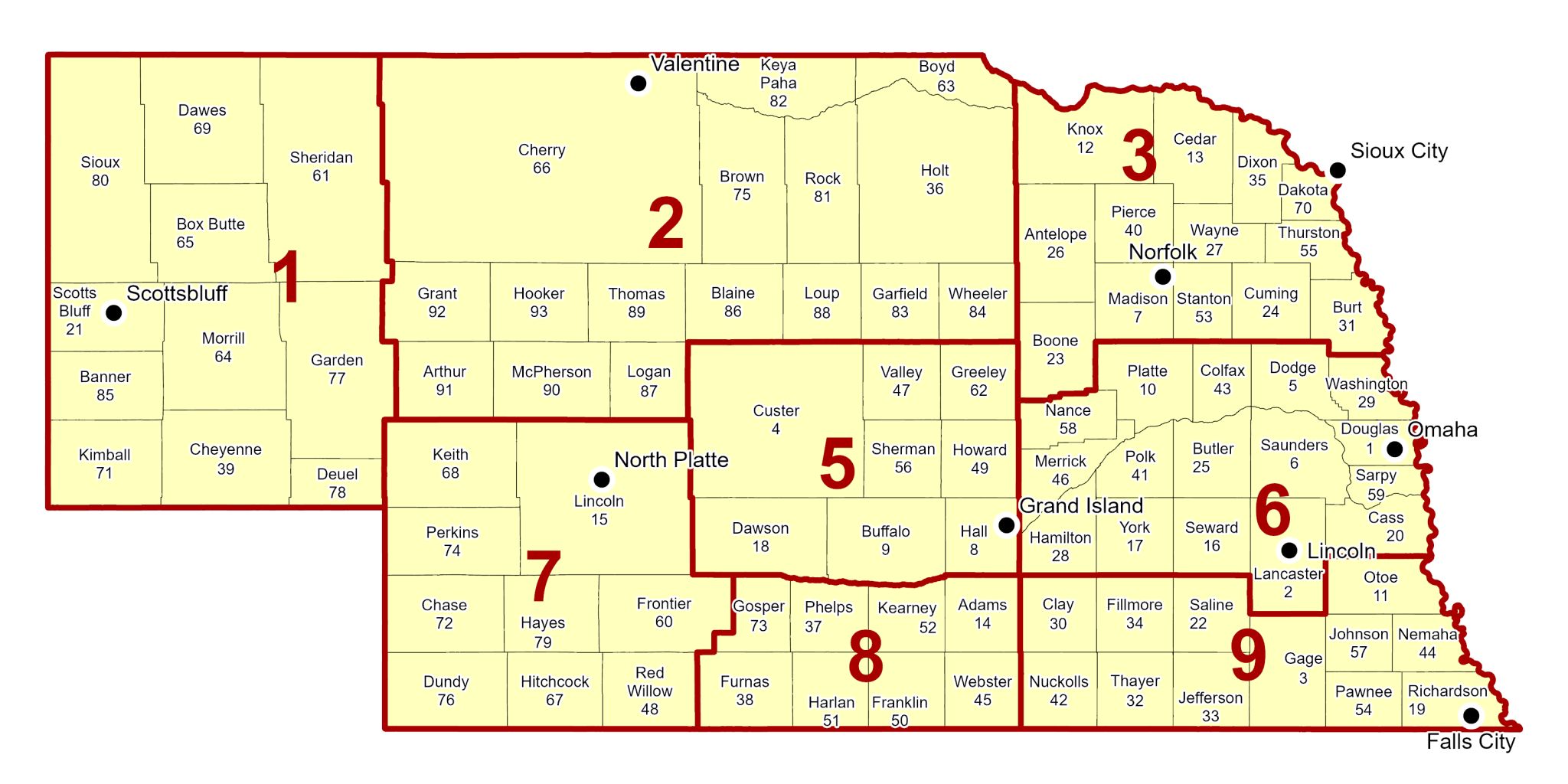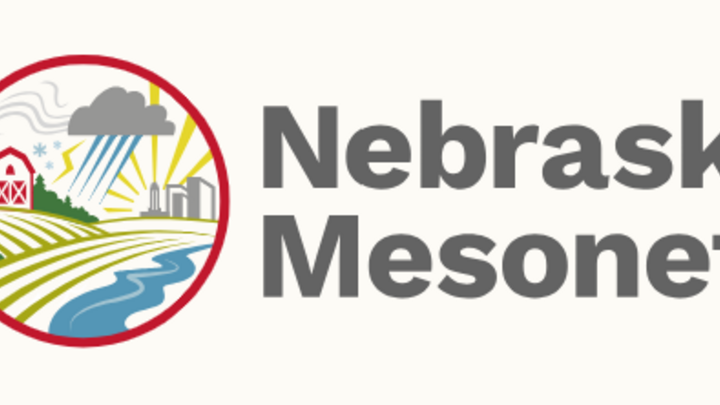Widespread stress observed
Drought is a growing problem across the state and a feature article on the latest drought conditions will be posted later in the week when the latest USDM is released. The purpose of this article is to feature what has been submitted to the Drought Mitigation Center's Condition Monitoring Observer Reports (CMOR) website to get a feel for how bad conditions may be and possible impacts. Exact locations and the name of the person(s) submitting reports have been withheld. The six reports cover the state from the Panhandle to southeast Nebraska. A map of the counties around the state is shown below.

Figure 1. County map of Nebraska. The large red, bold numbers represent the climate divisions and the small numbers are the numbering system for license plates.
Report 1:
State/Territory: Nebraska
County/Equivalent: Sheridan (Panhandle Climate Division)
Date: 5/6/2025
When was it like this in the past?
2012
How localized or widespread are the conditions you are reporting?
Widespread, several townships
Range conditions:
Poor - Pastures are providing marginal feed; supplemental feeding required.
Livestock production:
• Reduced pasture, forage • Feeding hay early • Supplemental feed • Animal stress • Less water in ponds, creeks, etc. • Sold livestock
Description and/or caption information:
Very little soil moisture. Through the first week of May, no precipitation has fallen. Wind has been especially devastating. Soil erosion has become widespread to the point of moving dirt around the tires of vehicles parked for more than 24 hours.
Report 2:
State/Territory: Nebraska
County/Equivalent: Kimball (Panhandle Climate Division)
When was it most recently like this?
2022
How localized or widespread are the conditions you are reporting?
At least 70 square miles
Crop conditions:
Poor - Heavy degree of loss of yield potential which can be caused by excess soil moisture, drought, disease, etc.
Planting status:
Earlier than normal
Harvest status:
Earlier than normal
Crop production:
• Reduced yield • Plant stress • Less water in ponds, creeks, cisterns, etc.
Range conditions:
Very Poor - Pastures provide very little or no feed. Supplemental feeding is required to maintain livestock condition.
Livestock production:
• Reduced pasture, forage • Feeding hay early • Supplemental feed • Purchased hay • Decreased stock weights • Animal stress • Less water in ponds, creeks, etc. • Sold livestock
Fire impact:
• More fires than normal • Increased risk of fires (strong winds and dry soils)
Description and/or caption information:
no cool season grass coming cows are still being heavily fed wheat is poor at best forcing early maturity
Report 3:
State/Territory: Nebraska
County/Equivalent: Lancaster (East Central Climate Division)
Date: 5/5/2025
When was it most recently like this?
2023
How localized or widespread are the conditions you are reporting?
VERY WIDESPREAD
Planting status:
Earlier than normal
Harvest status:
Earlier than normal
Crop production:
• Reduced yield • Plant stress • Erosion • Less water in ponds, creeks, cisterns, etc.
Range conditions:
Poor - Pastures are providing marginal feed; supplemental feeding required.
Livestock production:
• Reduced pasture, forage • Feeding hay early • Supplemental feed • Purchased hay • Decreased stock weights • Animal stress • Reduced grazing on public lands • Less water in ponds, creeks, etc. • Hauled water • Sold livestock • Erosion
Public health impact:
• Change in air quality, dust, pollen • Garden needs more water or yields less
Household impact:
• Dry lawn
Home and garden impact:
• Increased supplemental irrigation • Wilting on perennial flowers/shrubs • Dry lawn (browning in growth season) • Dusty/cracked soil
Home and garden - shrub and tree condition:
• Dead branch tips and/or dead top • Dead shrubs or trees
Recreation or tourism impact:
• Park or lake closed • Reduced boating, rafting • Less-appealing landscape • Hunting or fishing reduced
Fire impact:
• More fires than normal
Wildlife habitat impact:
• Less food for wildlife • Less water for wildlife • Water quality reduced
Freshwater fish impact:
• Less food available for fish • Less water in ponds, creeks, etc. • Reduced flow in streams and rivers • Water quality change • Fish disease or mortality • Reduced fishery production
Report 4:
State/Territory: Nebraska
County/Equivalent: Lancaster (East Central Climate Division)
Date: 5/5/2025
When was it most recently like this?
2024
How localized or widespread are the conditions you are reporting?
Extremely Widespread
Crop conditions:
Poor - Heavy degree of loss of yield potential which can be caused by excess soil moisture, drought, disease, etc.
Planting status:
Earlier than normal
Harvest status:
Earlier than normal
Crop production:
• Less water for irrigation • Reduced yield • Plant stress • Erosion • Less water in ponds, creeks, cisterns, etc.
Range conditions:
Very Poor - Pastures provide very little or no feed. Supplemental feeding is required to maintain livestock condition.
Livestock production:
• Reduced pasture, forage • Feeding hay early • Supplemental feed • Purchased hay • More invasive species (plants) • Decreased stock weights • Animal stress • Reduced grazing on public lands • Less water in ponds, creeks, etc. • Hauled water • Sold livestock • Erosion
Recreation or tourism impact:
• Park or lake closed • Reduced boating, rafting • Less-appealing landscape • Hunting or fishing reduced
Report 5:
State/Territory: Nebraska
County/Equivalent: Adams (South Central Climate Division)
Date: 5/4/2025
How localized or widespread are the conditions you are reporting?
Wide spread. We are having to run irrigation just to get the crops to come up. I’ve seen pivots running from here to the east up to the York NE area. The Platte River is more sand bars than water which says it’s dry to the west also. The pastures do not look good.
Crop conditions:
Poor - Heavy degree of loss of yield potential which can be caused by excess soil moisture, drought, disease, etc.
Planting status:
Later than normal
Crop production:
• Increased irrigation • Less water in ponds, creeks, cisterns, etc.
Range conditions:
Poor - Pastures are providing marginal feed; supplemental feeding required.
Livestock production:
• Reduced pasture, forage • Feeding hay early
Fire impact:
• More fires than normal • More intense fires • Increased risk of fires (strong winds and dry soils)
Description and/or caption information:
Wide spread severe drought. We are having to run irrigation just to get the crops to come up. I’ve seen pivots running from here to the east up to the York NE area.
Report 6:
State/Territory: Nebraska
County/Equivalent: Grant (North Central Climate Division)
Date: 5/2/2025
How dry or wet is it? Moderately Dry
How much experience do you have with conditions there?
10-20 years
How many times in the past have you seen it like this?
Other
How many times in the past - Other
6
How localized or widespread are the conditions you are reporting?
widespread its dry and blowing sand
Range conditions:
Poor - Pastures are providing marginal feed; supplemental feeding required.
Livestock production:
• Reduced pasture, forage • Feeding hay early • Supplemental feed • Purchased hay • More invasive species (plants) • Decreased stock weights • Animal stress • Mortality in livestock • Less water in ponds, creeks, etc. • Sold livestock


